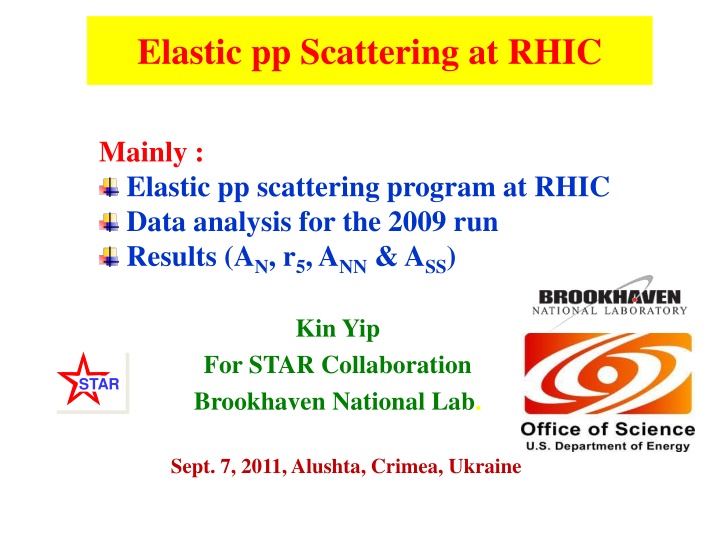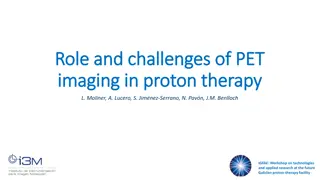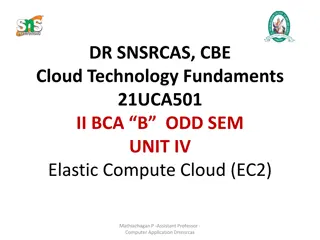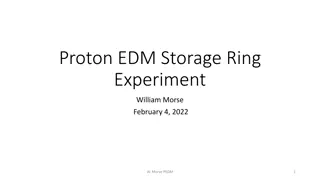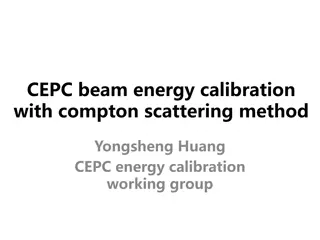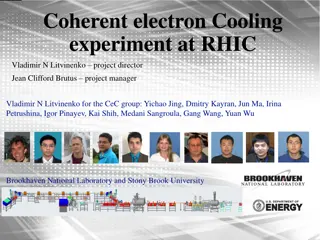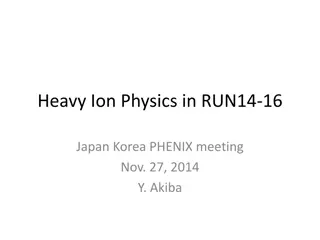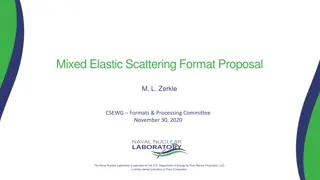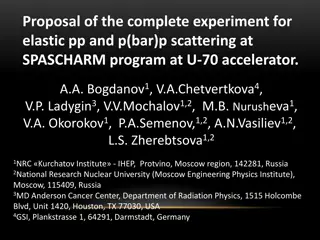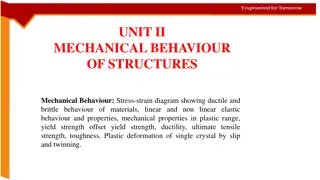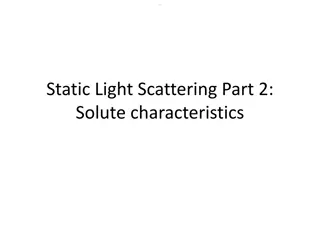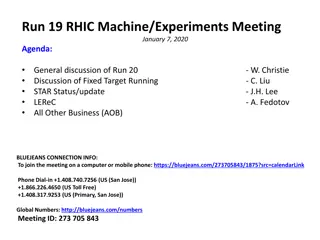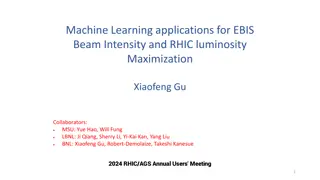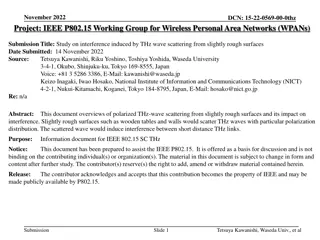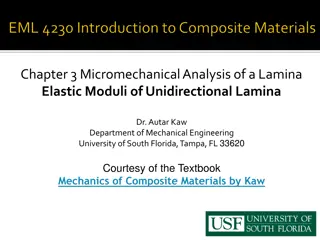Elastic Proton-Proton Scattering at RHIC Data Analysis for 2009 Run
Elastic proton-proton scattering program at RHIC, including results analysis and experimental setup details. Explore the physics with tagged forward protons and helicity amplitudes for spin. Learn about spin interaction and measurements in the CNI region at RHIC.
Download Presentation

Please find below an Image/Link to download the presentation.
The content on the website is provided AS IS for your information and personal use only. It may not be sold, licensed, or shared on other websites without obtaining consent from the author.If you encounter any issues during the download, it is possible that the publisher has removed the file from their server.
You are allowed to download the files provided on this website for personal or commercial use, subject to the condition that they are used lawfully. All files are the property of their respective owners.
The content on the website is provided AS IS for your information and personal use only. It may not be sold, licensed, or shared on other websites without obtaining consent from the author.
E N D
Presentation Transcript
Elastic pp Scattering at RHIC Mainly : Elastic pp scattering program at RHIC Data analysis for the 2009 run Results (AN, r5, ANN & ASS) Kin Yip For STAR Collaboration Brookhaven National Lab. STAR Sept. 7, 2011, Alushta, Crimea, Ukraine
RHIC-Spin Accelerator Complex RHIC pC CNI polarimeters absolute pH polarimeter Former location of pp2pp RHIC Siberian Snakes Siberian Snakes PHENIX STAR Spin Rotators * ~ 21 m for pp2pp/STAR in 2009 LINAC BOOSTER 5% Snake Pol. Proton Source AGS AGS quasi-elastic polarimeter AGS pC CNI polarimeter RF Dipoles 200 MeV polarimeter 15% Snake 2 Sept. 7, 2011 Kin Yip
Physics with Tagged Forward Protons QCD color singlet exchange: C=+ =+1, C= = 1 azimuthal p + p p + X + p rapidity p + p elastic p + p Double Pomeron Exchange (DPE) diffractive X= particles, glueballs Discovery Physics Single Diffraction Dissociation (SDD) Sept. 7, 2011 3 Kin Yip
Helicity amplitudes for spin Sept. 7, 2011 Kin Yip 4
AN and Nuclear Coulomb Interaction In the absence of hadronic spin-flip contributions, AN is exactly calculable. [Kopeliovich & Lapidus, Sov. J. Nucl. Phys. 19, 114 (1974).] Our data reach N.H. Buttimore, et al., Phys. Rev. D 59 (1999) 114010. 5 Sept. 7, 2011 Kin Yip
Previous AN measurements in the CNI region with hadronic spin-flip no hadronic spin-flip HJet@RHIC PRD79(09)094014 HJet@RHIC PRD79(09)094014 no hadronic spin-flip E704@FNAL s = 19.4 GeV PRD48(93)3026 pp2pp@RHIC s = 200 GeV PLB632(06)167 no hadronic spin-flip 6 Kin Yip Sept. 7, 2011
Implementation at RHIC Detectors Horizontal (55 m) Vertical (58 m) IP (STAR) Vertical (-58 m) Horizontal (-55 m) Silicon pitch is ~100 m Kin Yip Sept. 7, 2011 7
Roman Pots (RP) moved to STAR Vertical and Horizontal RP setup for a complete coverage 8 Kin Yip Sept. 7, 2011
Roman pots and transport Scattered protons have very small transverse momentum and travel with the beam through the accelerator magnets Roman Pots (RP) allow to get very close to the beam without breaking accelerator vacuum (~ 12 ) Optimal detector position is where scattered particles are already separated from the beam and their coordinate is most sensitive to the scattering angle through the machine optics Beam transport equations relate measured position at the detector to scattering angles : a11 a13 a14 x y ???? The most significant matrix elements are Leff s , so that approximately : x x* ? ???? x* y* a21 a22 a23 a24 a31 a32 a33 a41 a42 a43 a44 xD x* ? ???? ? ? yD y* ???? y y* IP D Kin Yip 9 Sept. 7, 2011
Silicon Detector Performance in the 2009 run After excluding (3) edge strips and hot/dead strips Only 5 dead/noisy strips per ~ 14000 active strips (active area limited by acceptance) Overall plane efficiency > 99%. Excellent detector efficiencies allow us to have clean data. 10 Sept. 7, 2011 Kin Yip
2009 run and main Selection Cuts Data was taken in 5 days ~July 2009 >70 million triggers Elastically triggered ( ~33 million events) Outside sequencer (DAQ) reset time window Valid hit/strip with ADC pedestal_per_channel + 5 A Cluster: 5 valid consecutive hits with ADC sum separated from the pedestal (depending on size) Clusters in A/C and B/D strips are within < 200 m (2 strips) A track on each side (a track is formed by at least a cluster on each Roman Pot) Collinearity (between the scattering angles in the East and West) Timing-vertex cut Fiducial cuts and getting rid of hotspots in the RP s nearest to the beam (~tail of the beam) ~21 million events (before considering the spin combinations) 11 Sept. 7, 2011 Kin Yip
Collinearity cuts mean & (position) determined from each run A typical distribution of x = [ x(West) x(East)] and y = [ y(West)- y(East)] for a run is shown here. Width here is consistent with the beam divergence. Kin Yip 12 Sept. 7, 2011
Calculation of single-spin asymmetry AN Square root formula: don t need external normalization, acceptance asymmetry and luminosity asymmetry cancel out We have all bunch polarization combinations: can build various asymmetries , , , Both beams polarized half of the statistics, but effect ~ (PB+PY) One beam polarized, the other unpolarized full statistics, but effect is only ~PB (or PY) Opposite relative polarization effect ~ (PB PY) should be close to 0 systematics check ++ ++ ( ) + + + ( ) + + + ( ) ( ) N N N N ( ) cos P P A + ( ) = = B Y N N 1 ( ) ++ ++ ( ) ( ) ( ) ( ) N N N N + + ( ) + + + ( ) + + ( ) ( ) N N N N ( ) = = B + B B B + B N cos P A B N ( ) ( ) ( ) ( ) N N N N B B B B + + + + ( ) + + + ( ) + + ( ) ( ) N N N N ( ) cos P P A N ( ) = = B Y N 1 ( ) + + + + ( ) ( ) ( ) ( ) N N N N where and is the azimuthal angle. = + 2 2 ( ) ( cos sin ) 0.01 1 B Y P P A A NN SS Beam polarization*: PB= 0.604 0.026 and PY= 0.618 0.028 (PB+PY)= 1.224 0.038, (PB PY)= 0.016 0.038 = 0.013(PB+PY) and there is an additional global error ~ 4.4% on (PB+PY). *Averaged for our fills from the official Run 09 CNI polarimeter results http://www4.rcf.bnl.gov/~cnipol/pubdocs/Run09Offline/ 13 Kin Yip Sept. 7, 2011
Preliminary results on AN and r5 cf. p. 6, much more accurate than our previous meas. ! 3 Our fit 2 1 no hadronic spin-flip 14 Kin Yip Sept. 7, 2011
Finalizing the analysis We have focussed our efforts to figure out the best and most accurate transport for the RHIC configuration that we have used during the 2009 run. Cross-checked the transport and the off-axis effects by established software such as MADX and Turtle (to arrive at the same result). Determined (eg.) the signs of angles and magnet strengths related to our experiment with the help of accelerator physicists and dedicated new/old beam experiments. Determining the best way to determine the scattering angle from positions in the RP s (using MC simulation to tell us the accuracies). We have spent a lot of time in alignment by detector position surveys in the RHIC tunnel and using the (over-)constraints from the elastic data to better align the detector geometry. A lot of systematic checks have been done. Eg.: 15 Kin Yip Sept. 7, 2011
East Only (all t) West Only (all t) ( ) ( ) ( ) ( ) 16 Kin Yip Sept. 7, 2011
A check to show that we understand the optics of our system: (Turtle) We compare the slope of the straight line fit of the angle (RP) vs the coordinates(RP) obtained from the data to the slopes of the fits in Turtle simulations when we vary the quad. strength. Our knowledge of the magnetic strength is better than 1%. (mrad) (cm) 17 Kin Yip Sept. 7, 2011
ANN and ASS Cannot use square root formula have to rely on normalized counts K+/ ( ) = + = 2 2 ( cos sin + + ) B Y P P A K K + A NN NN SS ++ + + + + ( ( ( ) ( ) ( )) ( )) ( ( ( ) ( ) ( )) ( )) K K K K K K = ++ + + All -t-ranges Double spin effects are seen but very small ANN ASS Both ANN and ASS are very small ~10 3 (except for the lowest t-range where larger systematic shifts may occur) Need better systematic error studies normalization are of the order of the effect Large systematic shift of 0-line is possible due to normalization current uncertainties STAR PRELIMINARY Sept. 7, 2011 18 Kin Yip
To summarize: >20 million good elastic events recorded in 5 days of data taking with RP s in 2009 at s=200 GeV and special machine optics *=21 m. Currently, we re trying to optimize the way to determine scattering angles from positions in RP s and complete the systematic studies. Upon completion, we should have the most precise measurement of AN in this energy range. We re preparing publication on AN and r5 and the knowledge gained is directly applicable to the other analyses: double-spin asymmetries ANN and ASS elastic scattering - spin averaged dN/dt => slope b etc. Planning a Phase II which may allow us to study diffractive physics (Central Production, Single Diffraction Dissociation and its spin dependence) and exotic physics etc. The pp2pp program at STAR helps explore physics potential and discovery possibilities at RHIC. 19 Kin Yip Sept. 7, 2011
